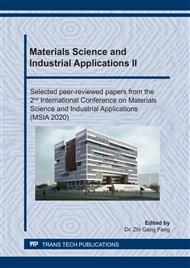p.175
p.181
p.191
p.196
p.202
p.207
p.212
p.219
p.224
Preparetion and Quantitative Analysis of Programmable Polyester Fiber
Abstract:
At present, the anti-counterfeiting fibers are mainly monochromatic fluorescent fibers, dual-band fluorescent fibers, and multicolor segment dyed fibers. However, anti-counterfeiting fibers using only these several anti-counterfeiting methods are increasingly unable to meet the needs of anti-counterfeiting technology for high efficiency, greenness, and security. This paper studies the method of setting passwords using multi-bit sequence programming in the spinning process, and enables passwords to be effectively stored throughout the fiber production and sales chain. Because nanoscale metal inorganic salts and metal oxide powders have good dispersion, they can be well and uniformly dispersed in the spinning solution. In addition, metal elements can be relatively stable in the spinning process, providing the possibility of traceability of programmable passwords. Setting a password in this method can effectively improve the anti-counterfeiting performance of the fiber without affecting the basic properties of the fiber, and will help to develop new technology for tracking and identifying anti-counterfeit fibers.
Info:
Periodical:
Pages:
202-206
Citation:
Online since:
July 2020
Authors:
Keywords:
Price:
Сopyright:
© 2020 Trans Tech Publications Ltd. All Rights Reserved
Share:
Citation:


